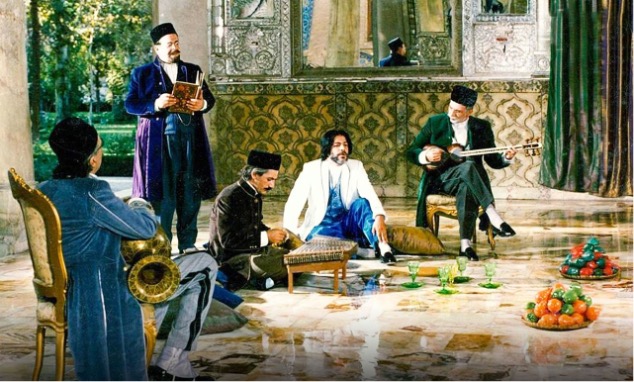
Black Seals: Missive from Iran’s National Music
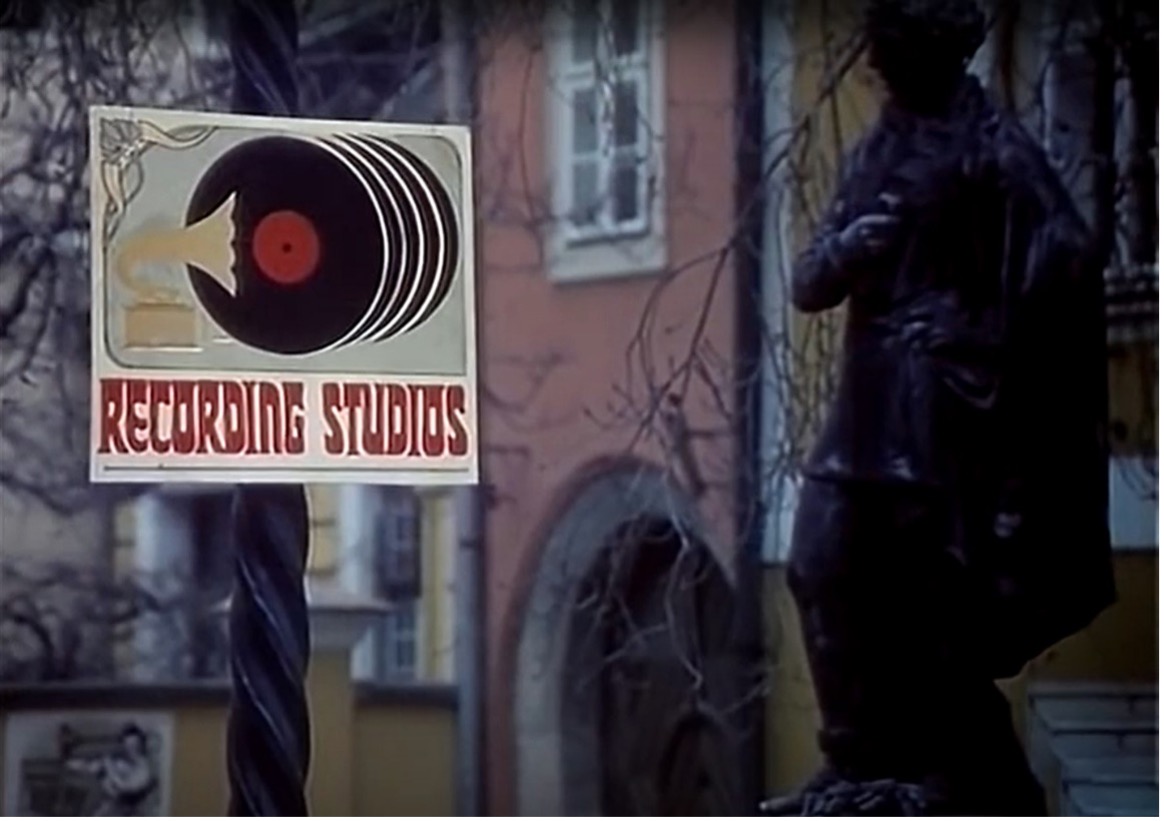
Figure 1: Still from the film Love Stricken (Dilshudigān), directed by ‘Alī Hātamī, 1992.
The cathedral leaves its locale to be received in the studio of a lover of art; the choral production, performed in an auditorium or in the open air, resounds in the drawing room.
—Walter Benjamin, The Work of Art in the Age of Mechanical Reproduction (1936)
Ultimately the phonograph records are not artworks but the black seals on the missives that are rushing towards us from all sides in the traffic with technology; missives whose formulations capture the sounds of creation, the first and the last sounds, judgment upon life and message about that which may come thereafter.
—Theodor W. Adorno, The Form of the Phonograph Record (1934)
This piece briefly traces the introduction of visual and aural representational technologies to Iran. It places the genealogy of these technologies within a history of exchange between the East and the West. Focusing on Love Stricken(Dilshudigān, 1992), a highly popular Iranian post-Revolution fiction film by director ‘Alī Hātamī, this piece maintains that this historical exchange nests in the practices of inscriptive technologies, and as such continues to affect their modes of enunciation over time, charging the language of representation with ambiguity. It thus attempts to chart the ambiguities that surface in close readings of the film’s thematic contents and the organization of the film’s discourse.
‘Alī Hātamī was one of Iran’s most prolific contemporary filmmakers until his untimely death at the age of 52 in 1996. Lauded as the master poet of Iranian cinema, the overwhelming popularity of his work for the screen in Iran has been noted for its heavy emphasis on dialogue and for its rich poetic language and composition. Although involved in the film industry before the Iranian Revolution, Hātamī’s work after the Revolution is known for introducing new innovations in what he referred to as “the historical genre.” 1Umīd Rawhānī, “ʿAlī Hātamī: Kārgardān-i Dilshudigān, ‘Man qālī mī’bāfam,’” Fīlm: Māh’nāmah-yi Sīnimā 2 (1378/1999): 541. In 1982 Hātamī made Hajji Washington (HājīWāshangtun), a film about the tribulations of the Persian ambassador to the United States during the reign of the monarch Nasir al-Dīn Shah Qājār (r. 1848-96). Two years later, in 1984, Hātamī made Kamal al-Mulk (Kamāl al-Mulk), a fictional film about the famous nineteenth-century Iranian painter in the court of Nasir al-Dīn Shah. Mother (Mādar), made in 1990, is one of Hātamī’s best-known films in the West. It excavates the buried histories of forced Westernization under Rizā Shah Pahlavī (r. 1925-41). Hātamī’s Love Stricken (sometimes rendered in English as The Enamored, or Haunted by Love), produced two years after Mother, follows a group of Iranian musicians who travel to Europe to record traditional music on the early gramophone. The film is set during the rule of Ahmad Shah Qājār (r. 1909-25). According to Hātamī, although the film is about the processes involved in the recording of music, “the specific historical figures” associated with the recording of traditional music are unimportant to the film itself. Hātamī’s aim in Love Stricken was to create characters that had no other identity except one that is associated with music. More than a documentary about the nation’s past, the film is a fictionalized reflection on the inscription and standardization of traditional music. As such, the film deals with the longue durée of contingencies that have surrounded and continue to inform the historical inscription of “the national” in representational technologies. The nation’s past and present are coeval in Love Stricken and, as such, interact in representational form. This insight is borne out in Hātamī’s discussion of the choices he made in directing the film: “I thought it would be interesting to show that early sound recording devices are curiosities not only for the contemporary audience of the film, but for my characters as well.”2Umīd Rawhānī, “ʿAlī Hātamī: Kargardān-i Dilshudigān, ‘Man qālī mī’bāfam,’” Fīlm: Māh’nāmah-yi Sīnimā 2 (1378/1999): 544. Fictional characters on the screen and audience members present before the screen are seen as inhabiting synchronous positions vis-à-vis mediating technologies – technologies that simultaneously plot the course of the narrative on screen and, at the same time, constitute and represent the nation’s identity, past and present.

Figure 2: Musicians performing in the royal palace, still from the film Love Stricken (Dilshudigān), directed by ‘Alī Hātamī, 1992.
This temporal confluence is used as a means to resist and upend the determining marks of standardization, which, put more forthrightly, is the stamp of the imperial domination of Hollywood globally. The “all-time” of musical history in Love Stricken is, in this way, brought into a messianic and revolutionary confrontation with the dominant force that standardizes vision and hearing. This intervention in cultural practices identifies precisely the site of struggle for Hātamī, a struggle that he also sees as any national cinema’s struggle against the homogenization of the medium of film itself. In order to confront the domination of Hollywood, Love Stricken embraces the “messianic all-time” of music, its recording, representation, and reception. Grounded in this redemptive temporal confluence, the film sees itself as confronting the imperial effects of cinematic standardization.
In my reading, Hātamī’s emphasis on the processes of production underscores the significance of cinema’s own productive technologies and the most obvious technological fork in film, namely that which separates the visual from the aural. Hātamī’s focus on the international history of cinema and on the processes of national production, by contrast, underscores the importance of that history to his project, emphasizing the international alongside the uniquely—and he insists, national—engagement with the mediating technologies. In light of this, the focus of my analysis of Love Stricken, will be a close reading of the meanings, messages, and contradictions forwarded on two tracks, sound and image. I insist on upholding the contradictions that arise within a secondary forking as well, namely those produced through the alternative positioning of the film narrative on the one hand and of enunciation on the other, as they refer to what is emphatically national. True, my approach abandons the hermeneutics of reading film as narrative, but it allows for a reflection on the enactive sites of culture in which the utopian image of the nation is produced.
Preoccupied with the processes involved in the production and inscription of sound and of national representation, Love Stricken repeatedly reflects on its own processes of production, that is, on what Christian Metz refers to as “filmic enunciation.”3One could think of enunciation as the organizing “source” of the film narrative. See Christian Metz, Impersonal Enunciation, or the Place of Film (New York City: Columbia University Press, 2016). For Hātamī, the specificity of cultural difference was to be inscribed within the source and process of production of the film itself. Metz articulates this more precisely, as the site of cinematic enunciation, where narrative meaning is produced, patterned, and organized. According to Hātamī, for Iranian cinema to be national, this process of ordering and patterning would have to signal the national difference: “I cannot tell an Iranian story on the patterns and production processes of the West. What I mean is, I have seen musicals or films about music in European and global cinemas, and I have seen many of them and with a great deal of attention. But what I am attempting to do, and this is where my efforts have converged in the last years, is to realize a language, a style, a production process that arrives through the clarity of Persian speech and Persian storytelling.” See Umīd Rawhānī, “ʿAlī Hātamī: Kārgardān-i Dilshudigān, ‘Man qālī mī’bāfam,’” Fīlm: Māh’nāmah-yi Sīnimā 2 (1378/1999): 545. What Hātamī means in referring to speech and narration is not dialogue precisely. National difference in his film must be conditioned by the specificity of “technique” and “style.” Thus, national difference for Hātamī is the difference that emerges not out of a difference in content and dialogue so much as in the determined ordering of undetermined elements—enunciation, more specifically. See Thomas Elsaesser, “From Sign to Mind: A General Introduction,” in The Film Spectator: From Sign to Mind, ed. Warren Buckland (Amsterdam: Amsterdam University Press, 1995), 12. John Mowitt’s important intervention on the role of enunciation, as that which joins text to industry in cinema, fleshes out this very cursory discussion of the unconscious site of national address in my own work. See John Mowitt, Re-Takes: Postcoloniality and Foreign Film Languages (Minneapolis: University of Minnesota Press, 2005). I will attempt to show the ways in which enunciation, as the landscape that inscribes the topography of film production and the unconscious site of the national address, self-reflexively reveals the very things that upend the messages and meanings produced by the film’s own narrative statements. In reading Love Stricken, then, I will discuss the ways in which narrative statements regarding the identity of the nation, the nation’s history, and its representation, are time and again contradicted by the histories and identities embedded within the film’s representational technologies and enunciative sources.
Love Stricken (1992)
Based in turn-of-the-century Iran, Love Stricken traces the peregrinations of a group of early-twentieth-century musicians to Paris to record traditional music on the newly invented gramophone. Historical in its leanings, the film narrative is preoccupied with the processes involved in the production of musical instruments and sound recordings. This preoccupation with production and inscription consistently reflects on the film’s own processes. Thus, the issue of production, national and aural, is clearly one of the concepts that the film offers up for analysis. Love Stricken’s narrative spans the period under the reign of Ahmad Shah, who ruled Iran during the revolutionary riots of 1909, riots that ultimately established a constitutional monarchy in Iran. While the film itself is emphatically ahistorical in its choice of characters and in its representation of historical events, it may be important to remark that the period in which the narrative is set is one of enormous turmoil in which Iran suffered a sad fate in the hands of an incompetent young monarch unable to resist European domination. The latter is a point left unacknowledged in the film narrative, which anachronistically overturns the conventional cultural hierarchies buried in the history of the film’s own technologies and instead sets Iran’s post-1979 moral economy in parity with the Western technological, economic, and political superiority at the turn of the twentieth century.

Figure 3: Closing credits of the film Love Stricken (Dilshudigān), directed by ‘Alī Hātamī, 1992.
The World
In the film, the young monarch, Ahmad Shah, is approached by one of his foreign advisors to assemble a traditional group of musicians to go to France to record music on the new foreign equipment. In effect, the musicians are to do what many did in this period, which is to traverse the space separating Tehran and Paris to bring back to Iran the product of a national modernity. The film’s thematic preoccupation with the history of sound recording in the Iranian constitutional era thus self-reflexively recalls the historical role played by the gramophone as studio sound displaced live musicians with sound that was prerecorded on a wax plate abroad. Inscribing the passage of time, the phonograph needle and reproducer would become catalysts for the reinscription of spaces, simultaneously destabilizing in this singular move, the traditional boundaries that were demarcated by sexual difference, demarcated, that is, by veils and walls.
The historian Farhang Rajā’ī observes that three early ventures to London, Paris, and Tbilisi by leading Iranian musicians were made to pursue the foreign “Gramophone Company’s” objective to record Iranian sound on a new invention.4Farhang Rajā’ī, Ganj-i Sūkhtah: Pazhūhishī dar Musīqī-i ʿAhd-i Qājār (Tehran: Ihyāʾ-i Kitāb, 1381/2002). Admittedly a slight groove in the otherwise extensive chronicle of sound recording, these traversals in space came toward the end of a civil war in Iran in which the nation’s past, its history, became the primary loci of struggles over the constitution of the nation’s modern identity.5Mohamad Tavakoli-Targhi, Refashioning Iran: Orientalism, Occidentalism, and Historiography (Hampshire and New York: Palgrave Macmillan, 2001), 142. The constitutionalists would in this struggle eventually take over Tehran, depose the Shah, and execute some of the anti-constitutionalists. The temporal configuration that conditions Hātamī’s historical film suggests that these events both precede and follow the film’s narrative setting. In the film, the present is a time out of time, a past-future conjunction that as “all-time.”
Love Stricken opens with a close-up shot of the interior of a mechanical music box, decorated on the exterior with a clock. Ahmad Shah stands next to the music box, enjoying the “voix céleste.”
Seated outside the royal palace, after an abrupt transition to the subsequent scene, Ahmad Shah expresses his desire for the world to be a music box “in which every voice is the sound of music and every conversation a song.” His minister informs him that a Monsieur Joli, a foreigner with a plan for recording music, has asked permission to gain audience with the Shah. As the modern monarch rides his bicycle in the park surrounding the royal palace conversing with the foreigner, in scene 3, he agrees to Monsieur Joli’s plan to gather up and record the sound of the traditional Iranian musicians abroad. Together, these three scenes locate the historical, technological, and affective contexts for the national inscription of traditional music on the phonograph record. What is important to note is that “the idea” of the phonograph is introduced in the film narrative, after the Shah has expressed his musical vision for the world. In the film, the monarch’s enjoyment of the music box is given as the motivating force behind the introduction of recorded music to Iran. Against the historical claims made about the forced commercialization of sound recording by the foreign “Gramophone Company,” the film formulates a historically motivated national rationale—that of desire and enjoyment– for the importation of recorded sound. In this way, the film’s opening sequence adjusts the sight lines of its audience to provide an altered perspective on modern national history from the perspective of the revolutionary present and a different look at the formation of Iranian identity in relation to it. In the film, the music box—a measure of temporality associated with its adorning clock—provides the genealogical ground, as well as the technological motivation, for the production of mechanized sound in Iran. The young monarch’s desire is set up by the film to charge the technology that will etch the groove of Iranian sound on a foreign wax plate. The Shah’s imaginary world, like the world of the film, situates the nation, a uniquely modern world, envisioned, mediated, and produced by mechanized music and song.

Figure 4: Ahmad Shah standing beside the music box, listening to its celestial sound, still from the film Love Stricken (Dilshudigān), directed by ‘Alī Hātamī, 1992.
Production
The scene that bears the overtures of the film doubly emphasizes the issue of production, this time national, artisanal, and technological. The scene depicts an old craftsman working on various parts of a new type of tār, a traditional Iranian string instrument made of wood. In close-ups and medium shots of the craftsman and the parts of the instrument that he is working on, the camera focuses on the steps involved in giving shape to the wood as the craftsman sands it, glues the parts of the instrument together, and finally polishes and strings the tār. Non-diegetic string music plays over this scene and rhythmically ushers the coming-into-being of a new instrument that advances innovations in Iranian traditional music. The overture, customarily a self-reflexive sequence in which films reflect on the means of their own coming into being, introduces Love Stricken’s actors, its film crew, and its director by name. As these credits roll, Love Stricken simultaneously catalogs the investment that the film has in interrogating the genealogy of an aural medium –a medium that comes to function as a mediator of national tradition. The credits roll as the old craftsman works on the tār. The craftsmen who produce the world of the film (the crew) and those artists who have been called to produce what will represent the nation to the world are introduced together in text and image form. Together these productive forces come to fulfill the young monarch’s vision of a world imbued with song and music. In accenting the processes of manufacturing, both visually and textually, the overture doubly signals the film’s interest in processes of production. This emphasis not only posits Iran’s musical history as a subject of cinematic reflection, but also the film’s reflection on itself as a produced object. That is to say, Love Stricken as a film made in an isolationist period in Iran’s post-revolutionary history that reflects on “a moment” in the history of national representation, also shows itself interested in interrogating the mediating processes by which any representation of nationhood comes into being.

Figure 5: An old craftsman carefully sanding and assembling a new tār, still from the film Love Stricken (Dilshudigān), directed by ‘Alī Hātamī, 1992.
What can be said about the genesis of the modern nation? What grounds this history and what motivates its evolution? What mediates the nation’s constitution? What impact does foreign influence have on the nation’s evolution? The emphasis on the processes of production in the opening sequences of the film pressures the historical context for the inscription of national representations and the influences of such representational technologies in the making of modern Iran and in crafting its identity. What marks and tempers national identity in this process of mediation?
The juxtaposition of innovations in traditional and modern musical technologies in the image track and the non-diegetic sound of studio-recorded string music on the overture sets the foundation for the questions that become fundamental for the film itself. The simultaneity of the two representations produces an analogic relationship between transformations in traditional representational media (tār music) in Iran and the technological innovations in (studio) sound recording associated with farang (Europe) in the film. Although the two innovations are posited as equally new, modern, and progressive in the film’s overture, the juxtaposition of studio sound and the visual attention to the process involved in the production of the traditional string instrument, split between the sound and the image track, reflexively recalls the historical role played by the gramophone as it displaced live musicians (who, we should remember, were artisans not unlike the film’s craftsman) with recorded film sound in the early years of film production everywhere. Thus the film seems to mourn an auratic national loss, while celebrating the gramophone’s reproducible sound—a celebration of a medium that was responsible for so many cultural and technological innovations, including sound films, which, far from being “talkies,” were more like primitive musicals, not unlike Love Stricken itself.
Testing
The scene in which the musicians are introduced opens to a group of four musicians testing the tār assembled in the course of the overture. The music is diegetic in this scene, emphasizing by contrast the use of non-diegetic studio music we hear in the scene setup in the overture. The mise-en-scène is structured as if on the set of a photo studio. In the scene, the musicians are framed by two landscape paintings and white pillars. Left over from the days of the Daguerreotype, when it was necessary for the photographic subject to lean and stand still during a twenty- to thirty-minute exposure time of “inorganic immobility,” such painted British garden backdrops would consistently frame photographs taken during the 19th century in Iran.
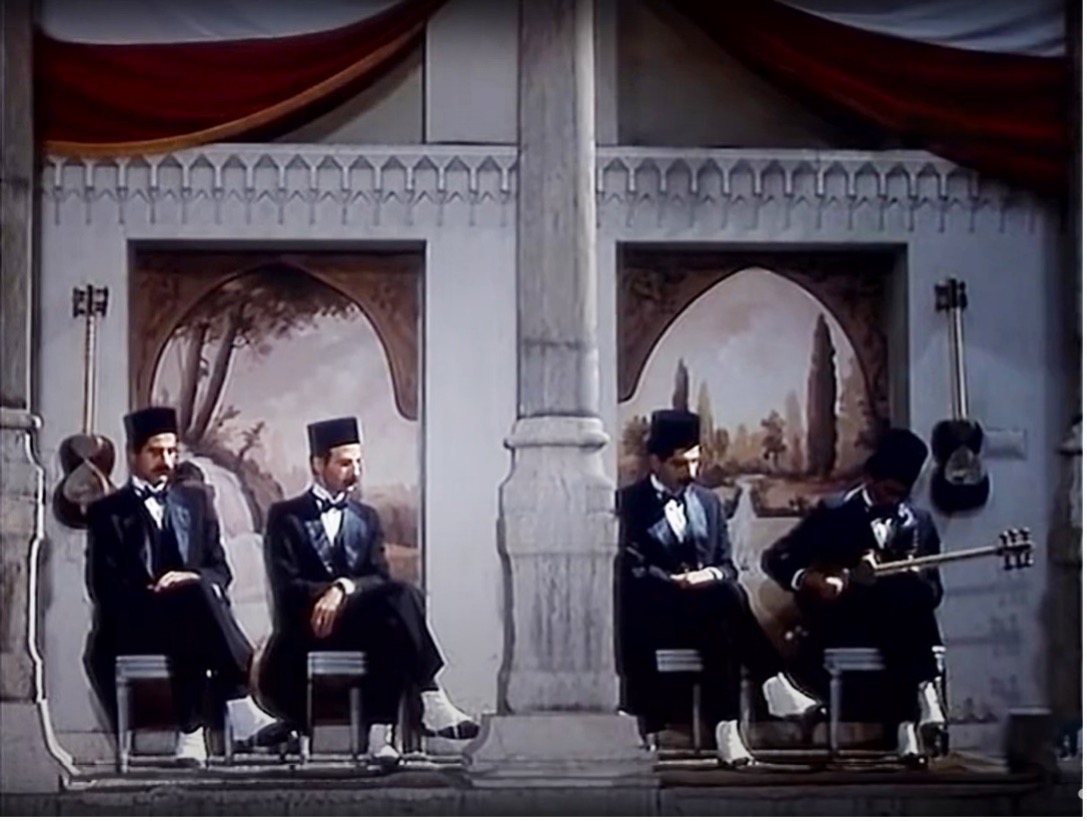
Figure 6: Four musicians performing in front of painted backdrops reminiscent of 19th-century photographic studios, still from the film Love Stricken (Dilshudigān), directed by ‘Alī Hātamī, 1992.
Love Stricken’s gesture of framing within the film frame suggests the film’s self-reflexivity. As such, the scene provides an overdetermined enunciative site that simultaneously ties the film to the early history of photography and the camera’s historical relation to the introduction of film technology to Iran. This scene, in which traditional live musicians play a newly invented national instrument against a photo-studio landscape, reflects on the genealogy of representational arts and their relation to the history of national modernity. In this genealogy, photography provides the earliest images of the encounter between machine and man.6Walter Benjamin, The Arcades Project, Konvolute J., ed. Rolf Tiedemann, trans. Howard Eiland and Kevin McLaughlin (Cambridge, Mass.: Harvard University Press, Belknap Press, 1999), 678. This scene, representing the musicians testing the new tār in Love Stricken, suggests that advancement in aural representative forms follows innovations in the visual arts. Historically speaking, in other words, the national subject has already traversed his/her groundedness in a specific geographic environment and interior landscape with the invention of the camera (referenced by the studio landscape), at the very moment when national sound loses its auratic context.
The European garden landscape that is represented in the photo-studio screen in this early scene provides the backdrop for the reproducibility of the national subject in effigy. The film foregrounds in this way the logic of transformation and the reconstitution of selves in and through the representational technologies of film. The subjects of the camera, in this scene, are transformed and transported into other settings through the process of mediation: Iranian men, playing traditional instruments, sit against the backdrop of a European landscape and are transformed by the context that frames them.
The film narrative also comes with a warning against the Western values as embedded in standardized representational strategies. In the scene in which the drummer converses with his wife and his mother about going to farang, the drummer’s wife asks if farang is the same place she has seen in the Shahr-i farang (literally, “City of Europe,” a popular peepshow in Iran that projected fantastic images of Europe), where the mosques have towers, she says, instead of domes? Inquiring about the distance of farang from Tehran, she says that she has seen the farangi women in the Shahr-i farang. She describes their perfumes and clothes and remarks that they look just like dolls and warns her husband not to let them “get into his frame” (narand tū jildit! i.e., “don’t fall for them”). Predictably, it is precisely these women that enter and disrupt the seams of the filmic frame as the musicians start recording their nationalist music on wax abroad.
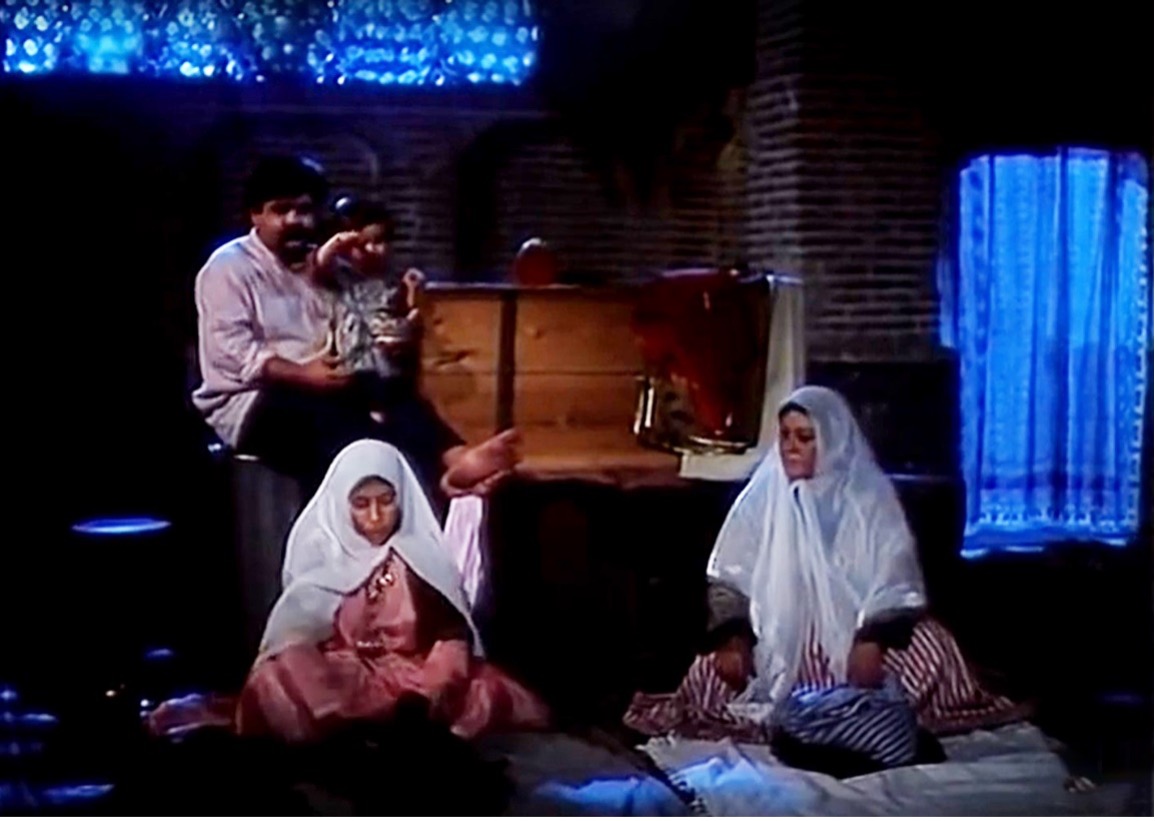
Figure 7: The drummer talking with his wife and mother about traveling to Farang (Europe), still from the film Love Stricken (Dilshudigān), directed by ‘Alī Hātamī, 1992.
The scene that follows, opens with a long shot of a European cityscape in which European men in top hats and suits walk arm in arm with European women in Victorian garments, bonnets, umbrellas, and white gloves. This scene, which represents the arrival of the musicians in Europe, also marks, by contrast, the nineteenth-century freedom of heterosexual exchange in the West. Repeated scenes such as this reveal a stark contrast between Iranian women who walk around Tehran covered by the veil and the unveiled women who the musicians encounter as they traverse the Parisian city streets, instruments in hand. This scene from the musicians’ traversal of the Paris streets recalls eighteenth- and nineteenth-century travelogue entries by Iranian voyagers to the West who describe Europe in terms of the status of European women and the public display of heterosexuality.
Missive 1
In Love Stricken, the scene signifying the musicians’ arrival in Europe by staging a heterosocial mise-en-scène is taken in long shot. As such, it comments on the film’s preceding scenes. In its juxtaposition of cultural differences (between the travelers and the Europeans), the film articulates its own struggle to find a representational grammar in keeping with Iran’s post-revolutionary modesty laws. On the level of the film narrative, these juxtapositions compare the moral superiority of an imagined “uncontaminated” and chaste Islamic culture of the contemporary moment to a generalized sense of European moral laxity.
Maintaining a short lens, the scene in Love Stricken anachronistically shows itself critical of European heterosociality and thus eludes censorship in the Islamic Republic. But this self-consciously anachronistic overture to the post-revolutionary theocracy’s sensibilities is merely a precursor to the actual site of recording, where the film’s argument regarding the production of modern national identity, and the function of representation in this context, is forged. The gramophone, identified by the film as the historical site for the construction and inscription of a modern Iranian identity, becomes the focal point of this articulation. The musicians’ arrival at the Parisian studio foregrounds the film’s emphatic preoccupation with the enunciative site of this national identity: as if obsessed with its displacement of the book as sole chronicle of national history and identity, the film repeatedly returns to the question and the role of representational culture and technology in relation to it. In this scene, the presence of recording equipment in the mise-èn-scene reflexively and deliberately underscores the status of the film’s narrative as mediated by representational technologies.

Figure 8: Iranian musicians recording their performance in a Parisian studio, still from the film Love Stricken (Dilshudigān), directed by ‘Alī Hātamī, 1992.
In the lead-up to this scene, the musicians walk out of the Pension de Paris to traverse the city in their stroll toward the recording studio. At the entrance, the English sign “Recording Studios” signals the Persian tongue’s indifference to the specificity of farang, as if to say “The other speaks in a foreign tongue, and we do not care if it is English or French.” Indoors, the next scene is set in the recording studio and emphasizes the status of recorded diegetic and non-diegetic sound as fundamental to the modern constitution of national identity through cinematic technologies. In this scene, as musicians set up and as the recording begins, what we hear on the sound track is diegetic sound. In other words, the music that we, as the audience, hear is coming from the instruments the musicians are actually playing within the visual frame. There is a sound synchronicity with the instruments we see played on screen.
As the singing begins, however, there is a cutaway to outside scenes, and the musicians start their stroll along the Parisian city streets once again. The sound we hear over the outdoor scene is studio recorded sound, and it is non-diegetic; that is, no instrument is shown to be playing the musical score. Studio-recorded music continues to play the score we heard the musicians play in the studio but the musicians now merely stroll and look about the Parisian city streets. What we hear as the scene returns to the recording studio is a continuation of this non-diegetic studio recorded musical score. The soundtrack no longer synchronizes with the instruments we see the musicians playing. The music that played outside wanders into the studio and plays independently of the musicians’ movements. Indeed, what seems to have taken place in the musicians’ traversal of the city on the visual track is so disruptive to the process of the recording that the drummer stops playing the score and starts wandering about the recording studio to satisfy his curiosity about the recording process itself.
What is marring the otherwise seamless montage is that the process of narrative construction—that process involved in the construction of a national identity through the film’s mediating technologies—seems to be unsettling the synchronous harmony between sound and image. It is as if what takes place on the street—namely, the heterosocial visual exchange in the foreign sites and the nondiegetic Iranian sound that accompanies the musicians’ traversal of the foreign city—is now being brought back into the studio and recorded along with the national music. This, indeed, is the message that is scopically mediated through the recording tube as the audience duplicates the drummer’s gaze peering into the tube to see the needle inscribing the sights of Paris and the sound of Iran on wax.
This slippage on wax is the enunciative backdrop to an ironically patriotic lyric poem that is sung into the gramophone. The repeated refrain in this poem identifies the singers as “the enamored” worshippers of neither East nor West (one of the slogans of the revolutionary years) and the lovers of the beloved nation, rendered symbolically by the iconography of the lion and the crowning sun—the century-old symbol of Iran.
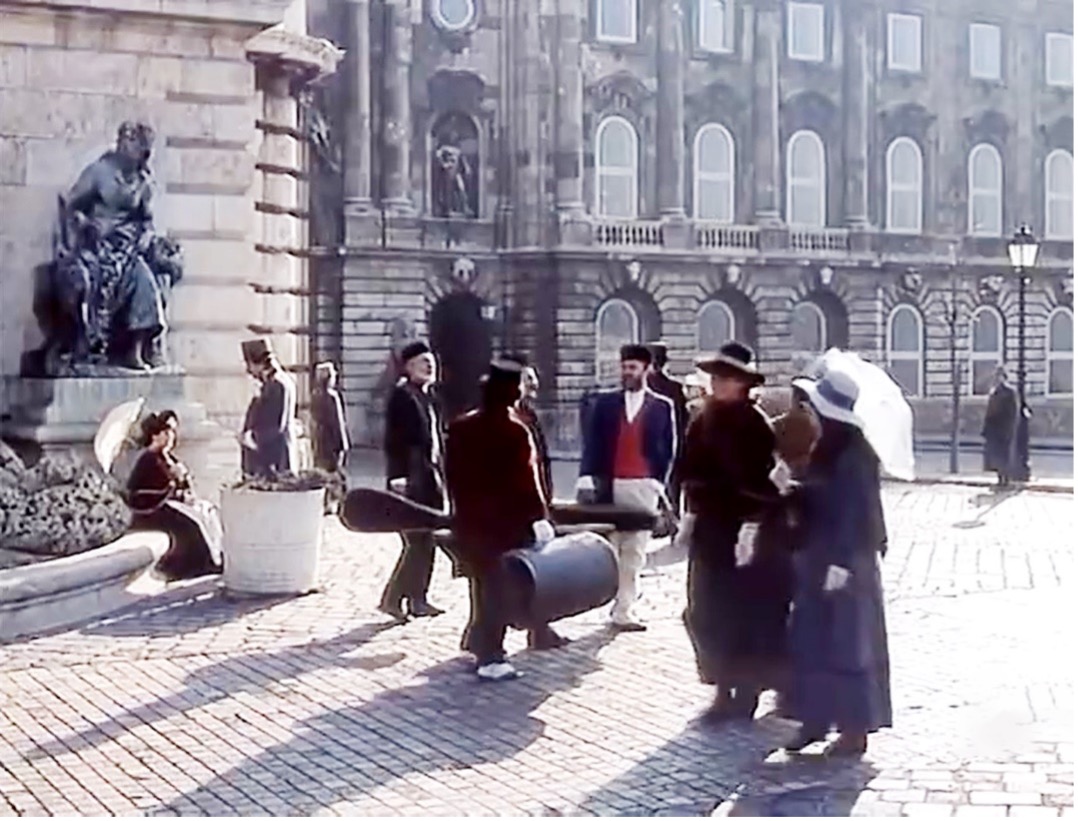
Figure 9: The musicians walking through the streets of Paris on their way to the recording studio, still from the film Love Stricken (Dilshudigān), directed by ‘Alī Hātamī, 1992.
Missive 2
In a subsequent scene in which the musicians regroup to play the same piece of music in a park, the question of enunciation is underscored anew. Here, the scopic and the aural become incommensurable and nonsynchronous once again. Set outdoors, the scene opens to a shot of a photographer and his female model. The model poses before the camera in the manner typical of late nineteenth-century carte de visite studio poses; that is, set against the backdrop of a European garden landscape. In this session, however, the conventional painted studio backdrop is absent. Contrasting with the early scene in which the musicians tested the new tār against the painted European landscape, the natural Parisian garden landscape takes the place of a studio screen. The oddity of playing out the scene of portrait photography outdoors is here underscored by the conversation that follows between photographer and model, where at the end of the session the model asks in French if they are going to do it again and he answers, “Yes, tomorrow, if the weather is good.” The exchange between the photographer and his model emphasizes the history of early photo-technology, which depended on the predictability of light available only indoors—in other words, only in studio spaces.
The presence of the camera, in this first shot, alerts the film’s audience to the status of its own vision as mediated and does so by foregrounding the technology that enables the images its audience sees on screen. With this emphasis on the mediating role of the camera, the musicians, in effect, become the after-images of the unveiled European model who, earlier in the sequence, is captured by a camera that reflexively stands within the narrative (as an alibi, one could say) for the film’s own camera.
As after-images of the unveiled European model, the musicians, representative of Iran abroad, forcefully wedge the question of national identity and cultural difference into an open ambivalence. While in the earlier scenes of the musicians’ arrival the camera kept its distance from the staging of heterosexuality on the Paris streets, thus asserting the superiority of Iran’s contemporary values, this scene situates both Europe and Iran within the same frame and simultaneously framed by the same lens. This comparative lens, now more ambivalent than that used to stage the musicians’ arrival, asks where contemporary Iran stands in relation to Europe, past and present. Given Iran’s dependence on mediating technologies that share an international history, how is the nation able to claim national purity in representation?
The status of sound becomes as important as the status of the visual in the film’s response.
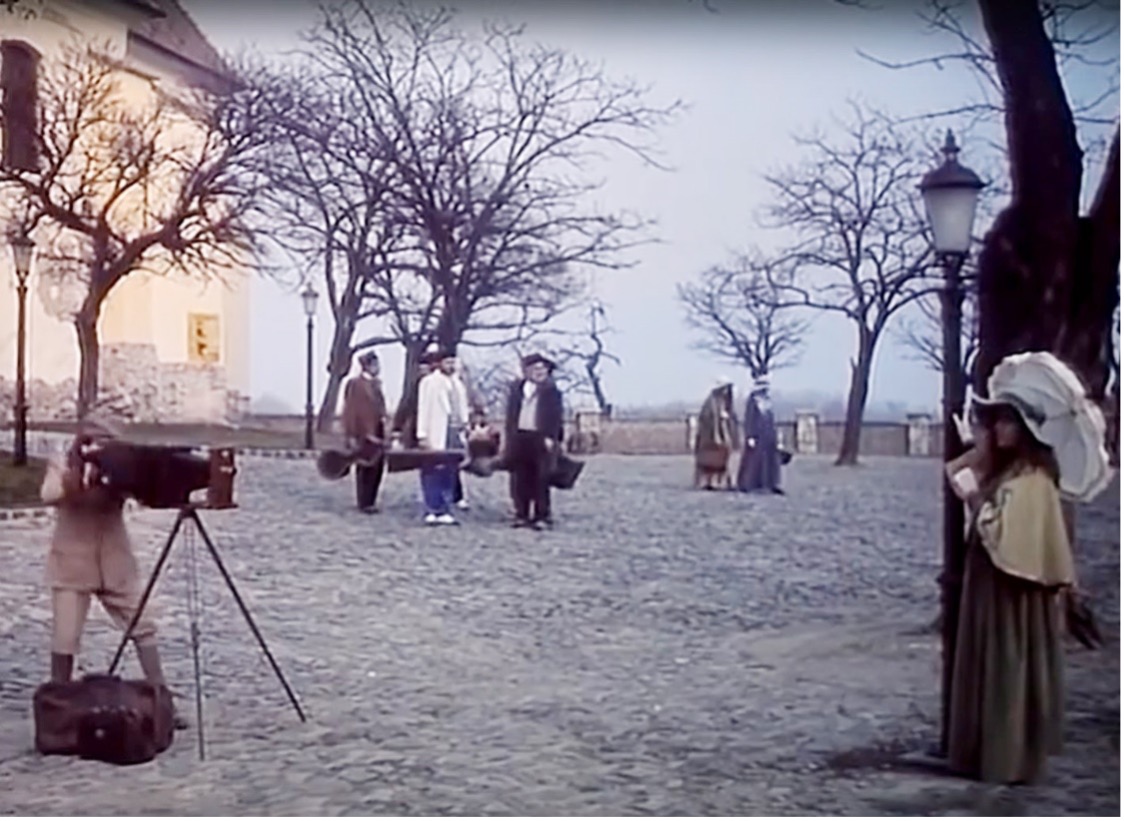
Figure 10: A female model posing for a photographer in a Parisian garden, still from the film Love Stricken (Dilshudigān), directed by ‘Alī Hātamī, 1992.
Missive 3
As the musicians start their practice, it becomes quite clear that the music that we are hearing is a studio recording played over the outdoor landscape. What has happened to the national music is precisely what should have happened, but did not, to the photographer’s session. Studio sound plays outdoors, and the outdoors becomes the site of carte de visite poses. In this way, the film reiterates the non-synchronicity of the scopic and aural. This enunciative incommensurability pressures the issue of national identity by mapping the production of national identity onto traversals in space, where what is being inscribed as modern Iran is externalized and then reconstructed and internalized on the backdrop of an intimate visual exchange between the European gaze eastward and the westward gaze of Iranian travelers in Europe.
Love Stricken foregrounds what Iranian films from the earliest post-revolutionary years demonstrated repeatedly in the form of a quiet political protest on the level of enunciation. Like many of its contemporaries, the film appears on the narrative level to comply with the demands put on the film and media industry to construct a national culture that shows Iran as critical of Western influence. It represents the national lifestyle as “traditional,” Shiʿite, and “pure,” even if anachronistically. The film’s self-reflexive return to the history of the technologies of reproducibility uncovers dormant genealogies, undoing any claim to a purified selfhood in national representation. Self-reflexive, Love Stricken’sgovernment-compliant narrative unfolds on a contestatory landscape of enunciation that shows how undeniably the nation and its cinema is produced on the grounds of cultural confluences, wedged in the contradictions of a forked tongue.
Cite this article

More than a documentary on the nation’s past, ʿAlī Hatamī’s Delshodegān (1992) offers a fictional meditation on the inscription, preservation, and standardization of traditional music as a site for imagining the nation. The film engages the longue durée of historical contingencies that have shaped—and continue to shape—the inscription of “the national” within modern representational technologies. In Delshodegān, the past and present coexist and interact within cinematic form: fictional characters on the screen and spectators before it occupy synchronous positions vis-à-vis mediating technologies that both propel the film’s narrative and construct the nation’s cultural self-image.
My analysis focuses on the tensions and meanings generated through the interplay of sound and image, tracing how each track enunciates competing, and at times contradictory, articulations of national identity. By privileging these contradictions—between narrative and enunciation, representation and performance—the paper moves beyond a hermeneutics of film as story to examine the enactive sites of culture through which the utopian image of the nation is staged and negotiated in the early stirrings of post-revolutionary Iranian cinema.



